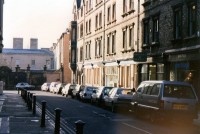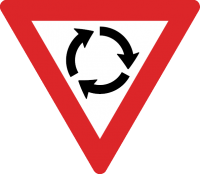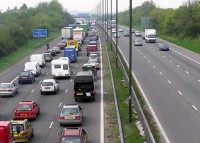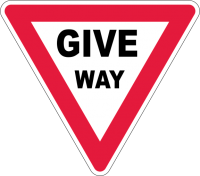Driving in the UK holds many challenges for an American tourist – starting with the fact that using the left half of the road instead of the right is far easier said than done. It can play havoc with your sense of positioning, especially if you rent a right- hand-drive vehicle, which will give you an entirely different perspective from what you are used to. You may well find yourself skimming dangerously close to the left extremity of your lane.
hand-drive vehicle, which will give you an entirely different perspective from what you are used to. You may well find yourself skimming dangerously close to the left extremity of your lane.
Driving on the left also means yielding to the left at intersections, overtaking on the right, finding right turns more complicated than left turns, and going clockwise around traffic roundabouts. Of course, this is all assuming that you get as far as mastering the gearstick with your left hand. Don’t try to use your feet the other way around, though – the accelerator pedal is still the one on the right.
 On top of all these complications, a lot of roadways in British towns are rather narrow. Many town centers were constructed before cars were widely owned – or even invented. Sometimes, that doesn’t only mean that the streets are very slender – it also means they have parked cars down both sides because the houses do not have garages. An experienced driver of UK town centers will be almost constantly weaving left and right, slowing and speeding up, to avoid hitting either parked cars or oncoming traffic. If it’s any consolation, British drivers sometimes find American roads intimidating to drive, as they are “too broad.”
On top of all these complications, a lot of roadways in British towns are rather narrow. Many town centers were constructed before cars were widely owned – or even invented. Sometimes, that doesn’t only mean that the streets are very slender – it also means they have parked cars down both sides because the houses do not have garages. An experienced driver of UK town centers will be almost constantly weaving left and right, slowing and speeding up, to avoid hitting either parked cars or oncoming traffic. If it’s any consolation, British drivers sometimes find American roads intimidating to drive, as they are “too broad.”
 Pedestrians are not as much of a persecuted minority in Britain as they are in America. Traffic light sequences are designed to avoid cars turning into streets at the same time that walkers have the all-clear to cross those streets. And motorists are not permitted to turn left – the British equivalent of right – on a red light. By the way, if someone talks about having a red or a green light, they are not necessarily talking about the signals for traffic. Pedestrians’ signals, too, are red and green.
Pedestrians are not as much of a persecuted minority in Britain as they are in America. Traffic light sequences are designed to avoid cars turning into streets at the same time that walkers have the all-clear to cross those streets. And motorists are not permitted to turn left – the British equivalent of right – on a red light. By the way, if someone talks about having a red or a green light, they are not necessarily talking about the signals for traffic. Pedestrians’ signals, too, are red and green.
If you step into a corner shop or a pub to ask directions, bear in mind that Brits are less likely than Americans to assume automatically that you are traveling by car. It’s worth clarifying that point before you get directed down a road that is reserved for pedestrians – not an uncommon thing in downtown areas.
 There are a few linguistic differences to deal with as well. A triangular sign that says “Give Way” is telling you the same thing as a US “Yield” sign. Freeways are called motorways – something that is reflected in these roads’ names, which consist of the letter M and a number. And if someone tells you that you are driving on the “pavement,” you have a problem, because this means the sidewalk.
There are a few linguistic differences to deal with as well. A triangular sign that says “Give Way” is telling you the same thing as a US “Yield” sign. Freeways are called motorways – something that is reflected in these roads’ names, which consist of the letter M and a number. And if someone tells you that you are driving on the “pavement,” you have a problem, because this means the sidewalk.
But at least there is one respect in which driving in Britain is less confusing, for an American, than driving in mainland Europe. At time of writing, Brits still differ from their European Union brethren by using what they call the “imperial” system of measurement. In plain English – they don’t use kilometers, but miles.

Nicole
Monday 11th of July 2011
The picture of the warning sign for a roundabout is upside down. By international convention, triangular signs are warnings, but the only one that points downward is the "Give Way" sign.
In the text, you talk of "yielding to the left". In the UK it is extremely rare to find a junction where the priority is not clearly indicated by white lines. There is no concept of giving way to the left at all, except at roundabouts where the rule is to give way to those already on the roundabout. In any case, this is giving way to the right.
I know whereof I speak here. I'm a driving instructor (a very heavily regulated activity in the UK).
When living in Italy in the historic centre of a town, I had a permit that allowed me to travel along certain streets to reach a piazza near my front door. There seemed to be an official truce that you wouldn't be ticketed between 8pm and 8am on week-nights despite what the signs said. When moving house, all my furniture had be offloaded from the articulated lorry onto small van that could fit in the tiny streets.
Having driven in many countries, including USA, one thing you'll notice is how disciplined and law-abiding British road-users tend to be.
Tuesday 6th of November 2012
I agree - if someone gives way to the LEFT they are likely going to get hit! Stop and yield signs are rare - most driving indicators are faded white lines on the road.
All I can say is American tourists PLEASE don't rent cars in our country and try to drive. It may look easy - but it isn't. You have no understanding of who has the right of way, how narrow the streets are or how, as the author has stated, your sense of postioning and perspective is completely skewed.
If you move here and live here and have a few sessions with an instructor you may be able to drive and not kill one of us (or yourself) - but getting off a plane and into a car is sheer Russian roulette. I work in the tourism industry and am all too familiar with Americans who think driving here is a "piece of cake" and end up getting into - and causing - traffic accidents.
Michael Tyson
Friday 6th of August 2010
Hi David, I've come at this issue from the other side - I'm an Australian (drive on the left) and have driven in continental Europe (drive on the right). You've nicely summed up the differences you'll find in the UK but I hope this article doesn't put anyone off driving in the UK. I found that I experienced about a 10 minute adjustment period and after that I was fine. In fact, after a while I got so used to driving on the right I started thinking that driving on the left seemed quite foreign! Sure enough, when I got back to the UK, I went through another short adjustment period back to driving on the left - I was a bit baffled about which direction to go in when I approached my first round-about but it was really nothing that I would call "stressful". In fact, we just had a bit of a laugh about it then followed the car in front of us.
Ditto with getting used to the imperial system (Australia is metric) and variations in signage. It took a couple of reminders about the conversion rate from miles to kilometres and that was that. If signage is something you want to bone up on before you get here you can buy the European Drivers Handbook, or something similar, which covers most countries in Europe - or just google it!
One thing that might be a valid stressor that you mentioned is road size. I didn't realise American roads are larger and I can see how that might cause a bit of anxiety. If you think British roads are narrow then you might not want to drive in Italian towns or cities at all. We drive a motorhome and there were quite a few times in Italy where we had mere millimeters of clearance. Now that is stressful! Driving in the UK after that is a piece of cake however, and we often find it quite humorous how carefully people drive down what they obviously think are narrow lanes!
So, unless you're a particularly nervous driver I wouldn't lose any sleep over it. If you're considering not driving in the UK because of such differences I heartily recommend you reconsider. Driving through the English countryside and avoiding motorways in favour of the more charming secondary roads has been one of the highlights of our trip!
Sophie
Thursday 5th of August 2010
I'm not American, but hail from a country where we drive on the right side of the road. Oddly, I find it more difficult to revert to driving on the right side when returning from Britain. It always takes a day or so before everything is as before. It's almost as if driving on the left is nature's way :)